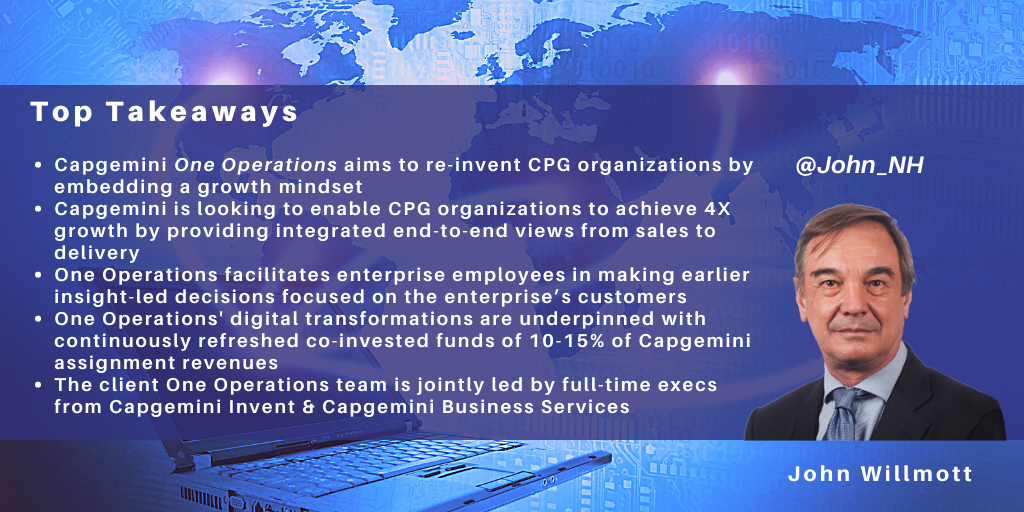Search posts by keywords:
Filter posts by author:
Related NEAT Reports
Other blog posts
posted on Aug 08, 2022 by John Willmott

Capgemini has launched a new digital transformation service, One Operations, with the specific goal of driving client revenue growth.
One Operations: Key Principles
Some of One Operations’ principles, such as introducing benchmark-driven best practice operations models, taking an end-to-end approach to operations across silos, and using co-invested innovation funds, are relatively well established in the industry. However, what is new is building on these principles to incorporate an overriding focus on delivering revenue growth. The business case for a One Operations assignment focuses on facilitating the client’s revenue growth and taking a B2B2C approach focused on the end customer, emphasizing the delivery of insights that enable client personnel to make earlier decisions focused on the enterprise’s customers.
Capgemini’s One Operations account teams involve consulting and operations working together, with Capgemini Invent contributing design and consulting and the operational RUN organization provided by Capgemini’s Business Services global business line.
Implementing a One Operations philosophy across the client organization and Capgemini is achieved through shared targets to reduce vendor/client friction and co-invested innovation funds. One Operations assignments involve setting joint targets with a continuously replenished co-invested innovation fund of ~10–15% of Capgemini revenues used to fund digital transformation.
One Operations is very industry-focused, and Capgemini is initially targeting selected clients within the CPG sector, looking to assist them in growing within an individual country or small group of countries by localizing within their global initiatives. The key to this approach is demonstrating to clients that it understands and can support both the ’grow’ and ’run’ elements of their businesses and having an outcome-based conversation. Capgemini is typically looking to enable enterprises to achieve 4X growth by connecting the sales organization to the supply chain.
Assignments commence with working sessions brainstorming the possibilities with key decision-makers. The One Operations client team is jointly led by a full-time executive from Capgemini Invent and an executive from Capgemini’s Business Services. The Capgemini Invent executive remains part of the One Operations client team until go-live. The appropriate business sector expertise is drawn more widely from across the Capgemini group.
One Operations assignments typically have three phases:
- Deployment planning (3–6 months) to understand the processes and associated costs and create the business case
- Deployment (6–15 months) to create the ’day one’ operating model
- Sustain, involving go-live and continuous improvement.
At this stage, Capgemini has two live One Operations assignments with further discussions taking place with clients.
Using End-to-End Process Integration to Speed Up Growth-Oriented Insights
Capgemini’s One Operations has three key design principles:
- Re-inventing the organization by embedding a growth mindset by reducing business operations complexity and enabling an AI-augmented workforce to focus on their customers and higher-value services
- Increasing the level of end-to-end integration by improving data accuracy and incorporating AI to achieve ’touchless forecasting & planning’ and enable better decisions and speed of innovation. ’Frictionless’ end-to-end integration is used to support more connected decisions and planning across the value chain
- Transforming at speed and scale.
These transformations involve:
- Shaping the strategic transformation agenda through defining the target operating model based on peer benchmarks and using standardized operating model design, assets, and accelerators
- Using a digital-first framework incorporating One Operations pre-configured digital process evaluation and digital twins
- Deployment of D-GEM technology accelerators, including AI-augmented workforce solutions and Capgemini IP such as Tran$4orm and ranging from platforms to microtools
- Augmented operations using Capgemini Business Services.
Changing the mindset within the enterprise involves freeing personnel from tactical transactional activities and providing relevant information supporting their new goals.
Capgemini aims to achieve the growth mindset in client enterprises by enabling an integrated end-to-end view from sales to delivery, facilitating teams with digital tools for process execution and growth-oriented data insights. Within this growth focus, Capgemini offers an omnichannel model to drive sales, augmented teams to enable better customer interactions, predictive technology to identify the next best customer actions, and data orchestration to reduce customer friction.
One Operations also enables touchless planning to improve forecast accuracy, increase the order fill rate, reduce time spent planning promotions, and accelerate cash collections to reduce DSO, while improving promotions accuracy and product availability are also key to revenue growth within CPG and retail environments.
Shortening Forecasting Process & Enhancing Quality of Promotional Decisions: Keys to Growth in CPG
The overriding aim within One Operations is to free enterprise employees to focus on their customers and business growth. In one example, Capgemini is looking to assist an enterprise in increasing its sales within one geography from ~$1bn to $4bn.
The organization needed to free up its operational energies to focus on growth and create an insight-driven consumer-first mindset. However, the organization faced the following issues:
- 70% of its planning effort was spent analyzing past performance, and ~100 touches were required to deliver a monthly forecast
- Order processing efficiency was below the industry average
- Approx. 30% of its trucks were leaving the warehouse half-empty
- Launching products was taking longer than expected.
Capgemini took a multidisciplinary approach end-to-end across plan-to-cash. One key to growth is the provision of timely information. Capgemini is aiming to improve the transparency of business decisions. For example, the company has rationalized the coding of PoS data so that it can be directly interfaced with forecasting, shortening the forecasting process from weeks to days and enhancing the quality of promotional decisions.
Capgemini also implemented One Operations, leveraging D-GEM to develop a best-in-class operating model resulting in a €150m increase in revenue, 15% increase in forecasting accuracy, 50% decrease in time spent on setting up marketing promotions, and a 20% increase in order fulfillment rate.
